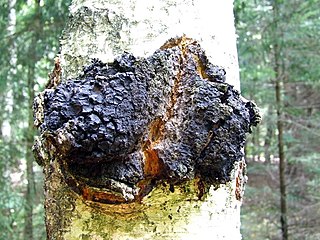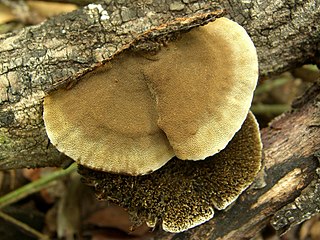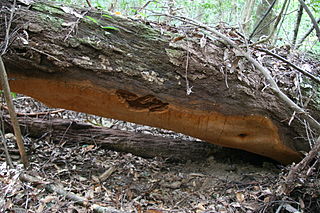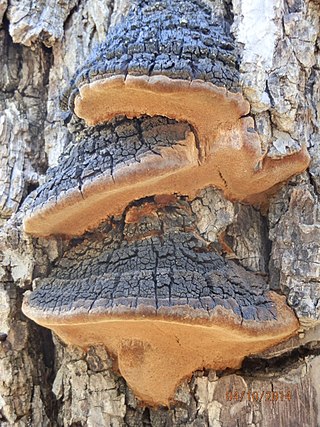
Polypores are a group of fungi that form large fruiting bodies with pores or tubes on the underside. They are a morphological group of basidiomycetes-like gilled mushrooms and hydnoid fungi, and not all polypores are closely related to each other. Polypores are also called bracket fungi or shelf fungi, and they characteristically produce woody, shelf- or bracket-shaped or occasionally circular fruiting bodies that are called conks. Over one thousand polypore species have been described to science, but a large part of the diversity is still unknown even in relatively well-studied temperate areas.

Laetiporus sulphureus is a species of bracket fungus found in Europe and North America. Its common names are sulphur polypore, sulphur shelf, and chicken-of-the-woods. Its fruit bodies grow as striking golden-yellow shelf-like structures on tree trunks and branches. Old fruitbodies fade to pale beige or pale grey. The undersurface of the fruit body is made up of tubelike pores rather than gills.

Inonotus obliquus, commonly called chaga, is a fungus in the family Hymenochaetaceae. It is parasitic on birch and other trees. The sterile conk is irregularly formed and resembles burnt charcoal. It is not the fruiting body of the fungus, but a sclerotium or mass of mycelium, mostly black because of a substantial amount of melanin.

Laricifomes officinalis, also known as agarikon, eburiko, or the quinine conk, is a wood-decay fungus that causes brown heart rot on conifers native to Europe, Asia, and North America, as well as Morocco. This fungus is the only member of the genus Laricifomes, in the order Polyporales. The fruiting bodies grow in large conks on the trunks of trees.

Pyrrhoderma noxium is a species of plant pathogen. It attacks a wide range of tropical plants, and is the cause of brown root rot disease. It has been described as "an aggressive and destructive pathogen". The pathogen invades roots with contact between roots of a potential host with the substrate on which the fungus is growing.

Hexagonia hydnoides, also known as the hairy hexagonia, is a widely distributed species of bracket fungus in the Polyporaceae family. The name comes from the species' distinctive dark hairy bristles found on the cap - hydnoides meaning 'relating to Hydnum,' a genus of toothed fungi. In general, it is known to grow in tropical regions across the globe and to grow on dead wood tissues, particularly that of hardwoods. It is a plant pathogen. This fungus is largely saprophytic, decaying dead wood tissues.

Meripilus giganteus is a polypore fungus in the family Meripilaceae. It causes a white rot in various types of broadleaved trees, particularly beech (Fagus), but also Abies, Picea, Pinus, Quercus and Ulmus species. This bracket fungus, commonly known as the giant polypore or black-staining polypore, is often found in large clumps at the base of trees, although fruiting bodies are sometimes found some distance away from the trunk, parasitizing the roots. M. giganteus has a circumboreal distribution in the northern Hemisphere, and is widely distributed in Europe. In the field, it is recognizable by the large, multi-capped fruiting body, as well as its pore surface that quickly darkens black when bruised or injured.

Phellinus igniarius, commonly known as the willow bracket, fire sponge,false tinder polypore, punk ash polypore, or false tinder conk, is a fungus of the family Hymenochaetaceae. Like other members of the genus of Phellinus, it lives by saprotrophic nutrition, in which the lignin and cellulose of a host tree is degraded and is a cause of white rot.

Daedaleopsis is a genus of fungi in the family Polyporaceae. The name Daedaleopsis is a reference to Daedalus, the labyrinth-maker of myth. Similarly, the maze-like pattern of pores is taxonomically described as being daedaloid. DNA was recovered and sequenced from fragments of a nearly 7000-year-old fruit body of D. tricolor found in an early Neolithic village in Rome.

Phellinus is a genus of fungi in the family Hymenochaetaceae. Many species cause white rot. Fruit bodies, which are found growing on wood, are resupinate, sessile, and perennial. The flesh is tough and woody or cork-like, and brown in color. Clamp connections are absent, and the skeletal hyphae are yellowish-brown.

Bridgeoporus is a fungal genus in the family Polyporaceae. A monotypic genus, it contains the single polypore species Bridgeoporus nobilissimus, first described to science in 1949. Commonly known both as the noble polypore and the fuzzy Sandozi, this fungus produces large fruit bodies that have been found to weigh up to 130 kilograms (290 lb). The upper surface of the fruit body has a fuzzy or fibrous texture that often supports the growth of algae, bryophytes, or vascular plants.

Fuscoporia torulosa is a species of bracket fungus in the genus Fuscoporia, family Hymenochaetaceae. A wood-decay fungus, it causes a white rot of heartwood in dead and living hardwood trees in Europe, and in coniferous trees in North America.

Inonotus dryadeus, commonly known as oak bracket, warted oak polypore, weeping polypore or weeping conk, is an inedible species of fungus belonging to the genus Inonotus, which consists of bracket fungi with fibrous flesh. Most often found growing at the base of oak trees, it causes white rot and decay of the trunks. It secretes an amber liquid which weeps from tubes in its upper surface.

Fomes fomentarius is a species of fungal plant pathogen found in Europe, Asia, Africa and North America. The species produces very large polypore fruit bodies which are shaped like a horse's hoof and vary in colour from a silvery grey to almost black, though they are normally brown. It grows on the side of various species of tree, which it infects through broken bark, causing rot. The species typically continues to live on trees long after they have died, changing from a parasite to a decomposer.

Phellinus ellipsoideus is a species of polypore fungus in the family Hymenochaetaceae, a specimen of which produced the largest fungal fruit body ever recorded. Found in China, the fruit bodies produced by the species are brown, woody basidiocarps that grow on dead wood, where the fungus feeds as a saprotroph. The basidiocarps are perennial, allowing them to grow very large under favourable circumstances. They are resupinate, measuring 30 centimetres (12 in) or more in length, though typically extending less than a centimetre from the surface of the wood. P. ellipsoideus produces distinct ellipsoidal spores, after which it is named, and unusual setae. These two features allow it to be readily differentiated microscopically from other, similar species. Chemical compounds isolated from the species include several steroidal compounds. These may have pharmacological applications, but further research is needed.

Lenzites warnieri is a species of fungus in the family Polyporaceae found in parts of Europe, Asia, and northern Africa. The species is a white rot pathogen on living wood. Its corky fruiting bodies in the shape of semicircular plates form on the trunks of several types of deciduous trees growing near water bodies in regions of moist sub-Mediterranean climate. The fruiting body, which has a lamellar fruit layer, produces spores only once.

Hapalopilus rutilans is a species of polypore fungus in the family Polyporaceae. Officially described in 1821, it was transferred to its current genus Hapalopilus six decades later. It is commonly known as the tender nesting polypore, purple dye polypore, or the cinnamon bracket. This widely distributed species is found on five continents. It grows on the fallen or standing dead wood of deciduous trees, in which it fruits singly, in groups, fused, or in overlapping clusters. Fruit bodies are in the form of kidney-shaped to semicircular, cinnamon-orange-brown brackets. The underside of the fruit body features a yellowish to brownish pore surface with tiny angular pores, from which spores are released.

Nigroporus vinosus is a species of poroid fungus in the family Steccherinaceae, and the type species of the genus Nigroporus. Its fruit bodies have brownish caps with tinges of purple or red. The cap underside has a pore surface the same colour as the cap, and minute pores. Nigroporus vinosus has a pantropical distribution. It has been recorded from Africa, North America, Central America, South America, Asia, and Oceania. It is a wood-decay fungus that causes a white rot.

Fulvifomes is a genus of fungi in the family Hymenochaetaceae. It was formerly considered synonymous with the genus Phellinus, but it was resurrected based on morphological and molecular phylogenetic evidence.

Phellinus arctostaphyli, also known as the manzanita conk or the manzanita hoof polypore, is a species of shelf fungus. Native to western North America, this saprotrophic fungus only colonizes the wood of Ceanothus, Adenostoma, and Arctostaphylos.P. arctostaphyli is closely to related to three other North American Phellinus species, including Phellinus tremulae and Phellinus tuberculosus. However, in part due to the "economic insignificance of its hosts," P. arctostaphyli is relatively poorly studied as an individual species.




















